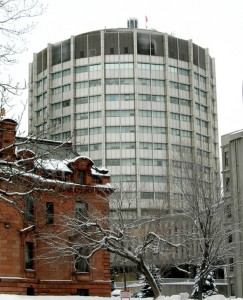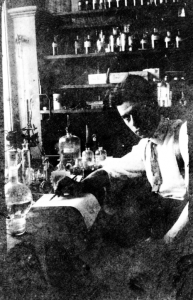By Jacob Siefring
 Back from the Life Sciences Library, I’ve some knowledge nuggets with which to distract you from the grueling last two weeks of this semester’s group projects and final papers.
Back from the Life Sciences Library, I’ve some knowledge nuggets with which to distract you from the grueling last two weeks of this semester’s group projects and final papers.
McGill’s Life Sciences Library, also known as the Osler Medical Library, is located on the third floor of the remarkably annular McIntyre Medical Building. The Medical Library was established in 1823, and it’s the oldest and first of the McGill University Libraries. The pictured building was completed in 1965.
I went in pursuit of a reference to a certain George Mines of McGill University that appears in “Inner Rhythms,” a chapter of Chaos: Making a New Science (James Gleick; 1987). Circuitously I was pointed in the direction of “Sudden Cardiac Death: A Problem in Topology” by Arthur T. Winfree, an article that appeared in Scientific American in 1983. Therein Winfree relates the following piece of esoterica:
On November 7,1914, George Ralph Mines was working in his laboratory in McGill’s School of Medicine. Because it was Saturday, there were few observers to notice Mines’s presence. A 28-year-old physiologist, Mines had been studying fibrillation, a radical disorganization of the heart’s pattern of contraction. He was a pioneer in his discipline.
“Mines had been trying to determine whether relatively small, brief electrical stimuli can cause fibrillation. For this work he had constructed a device to deliver electrical impulses to the heart with a magnitude and timing that could be precisely controlled. The device had been employed in preliminary work with animals. When Mines decided it was time to begin work with human beings, he chose the most readily available experimental subject: himself. At about six o’clock that evening a janitor, thinking it was unusually quiet in the laboratory, entered the room. Mines was lying under the laboratory bench surrounded by twisted electrical equipment. A broken mechanism was attached to his chest over the heart and a piece of apparatus nearby was still recording the faltering heartbeat. He died without recovering consciousness.” (Winfree, p. 144)
Fibrillation causes the deaths of several hundred thousand people annually in the U.S. alone, and — the defibrillator’s invention notwithstanding — its causes are still not well understood. Mines’s work on the heart was pioneering, because was “the first to demonstrate that fibrillation can develop after a relatively small electrical impulse if the impulse is applied to the heart at the right time.” (Normally, after an electrical impulse is applied to the heart, the cardiac rhythm is momentarily disturbed, but returns immediately to normal. Fibrillation — that violent and disorganized activity of the heart during which the heart may feel to the hand like a “wad of writhing worms” — does not occur in most instances of shock application.)

A.T. Winfree. When Time Breaks Down. Princeton UP, 1987. 42.
Apparently, the name given to that small but ever-critical interval during which an electrical stimulus will wreak utter havoc on the rhythmically synchronised functioning of cardiac cells — this critical time period is known as “the vulnerable phase.” For the sake of interdisciplinarity, I propose this term — “vulnerable phase” — as an apt descriptor of the time we’re now going through, the end of the semester. If you feel stressed, just think of George Ralph Mines, who died so unexpectedly “in the line of duty.” R.I.P., George Mines. Beware of electrical stimuli; long live research.

